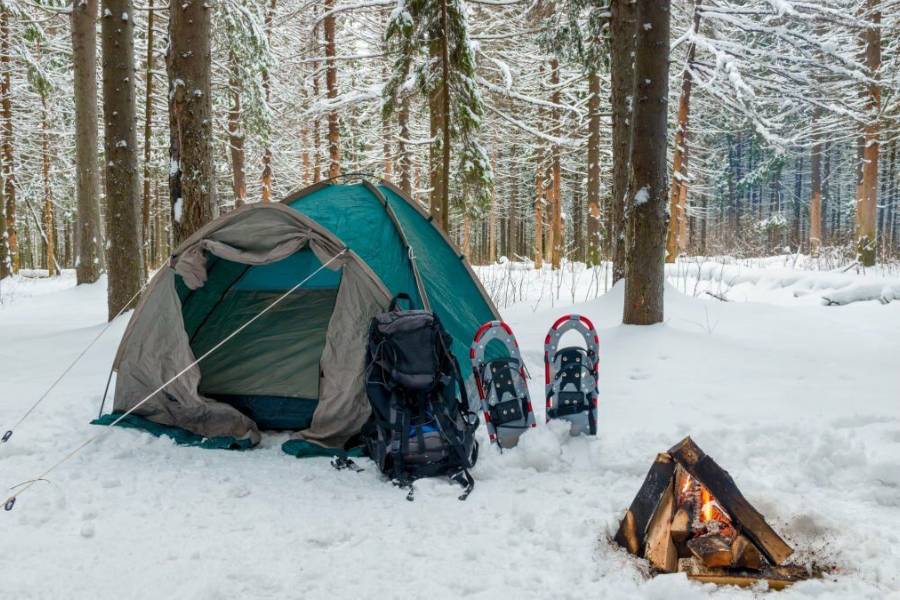
Camping in colder climates or during chilly seasons can be a rewarding experience. This allows you to connect with nature in a unique way. However, staying warm and comfortable is very important for an enjoyable outdoor adventure in the winter season. This is where effective tent heating comes into play.
In this guide, we’ll learn safe methods to heat a tent, ensuring a cozy and secure environment during your camping trip. From choosing the right heating device to implementing essential safety precautions, we’ll cover everything you need to know to keep warm without compromising on safety.
How to Safely Heat a Tent (5 Great Ways)
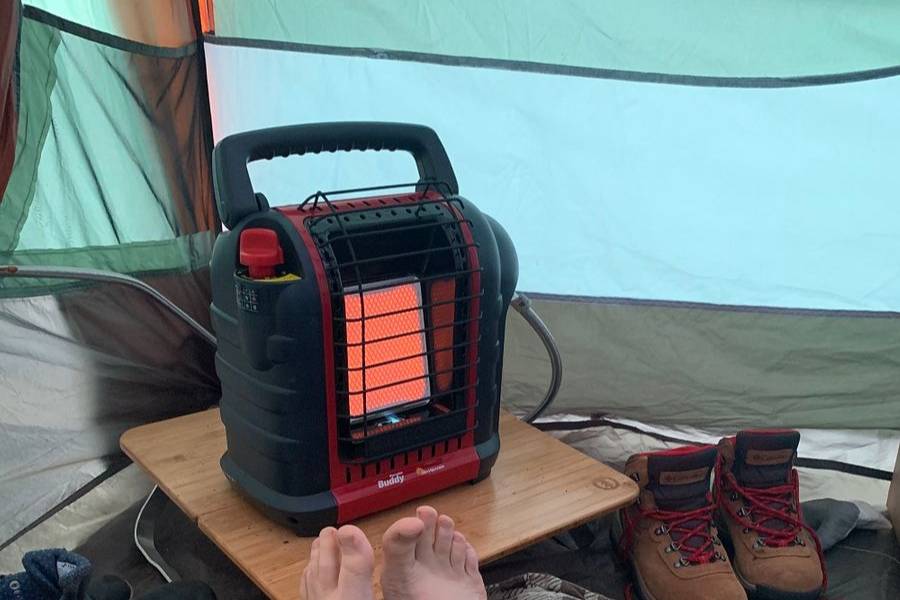
Selecting the right type of tent heater is pivotal. Each type comes with its own advantages and safety considerations. Let’s explore various methods for heating your tent.
Electric Tent Heaters
- For effective tent heating with an electric heater, start by selecting a unit equipped with safety features such as overheating protection.
- Then place it on a flat and stable surface away from flammable materials.
- Ensure some ventilation by slightly opening a window or the tent door.
- Position the heater centrally in the tent for even heat distribution.
- Use an appropriate extension cord to connect the heater to a power source. Then, simply turn on the heater and adjust the settings as per your comfort preferences.
Safety Considerations
- Confirm that the heater is designed for tent use and has adequate safety features.
- Use a reliable power source, like a generator with sufficient capacity.
- Keep the heater away from water sources to prevent electrical hazards.
- Avoid using extension cords if possible; use heavy-duty, outdoor-rated cords.
Propane Tent Heaters
- Before using a propane tent heater, make sure your tent is well-ventilated to prevent carbon monoxide buildup.
- Place the heater on a stable surface away from flammable materials,
- Connect a propane tank to the heater and check for any gas leaks using soapy water.
- Ignite the heater according to the provided guidelines.
- Adjust the heat settings to your comfort level, and always keep an eye on the heater while it’s in use.
Safety Considerations
- Check for gas leaks before igniting the heater using soapy water or a specialized leak detector solution.
- Provide adequate ventilation; leave a vent or window partially open.
- Turn off the heater before going to sleep to minimize the risk of accidents.
Wood Burning Stoves
- First, make sure your tent is compatible with a wood-burning stove and has a designated stove jack for the chimney.
- Set up the stove on a fire-resistant base and clear a safe zone around it.
- Use dry and seasoned firewood for efficient burning.
- Start a small fire and gradually add larger pieces of wood.
- Monitor the stove to maintain a safe temperature.
- Install the chimney through the stove jack and ensure it’s stable and properly sealed.
- Keep a fire extinguisher and carbon monoxide detector on hand for added safety.
Safety Considerations
- Position the stove on a fire-resistant surface and shield the area around it from sparks or embers.
- Install spark arresters and maintain a clear space around the stove to prevent fires.
- Ensure proper chimney setup to avoid smoke buildup inside the tent.
Chemical Hand Warmers
- Using chemical hand warmers to heat a tent is a temporary solution and not as effective as other methods. To do so, activate the hand warmers by exposing them to air and shaking them.
- Place the activated warmers in pockets, gloves, or hang them in the tent. While they can provide some warmth, they are not designed for large spaces, so consider using them in combination with other heating methods or as a supplement to your existing heating setup.
- Keep in mind that they have a limited duration of heat output and should be used with caution to avoid burns or damage to the tent fabric.
Safety Considerations
- Use hand warmers according to the manufacturer’s instructions; do not puncture or misuse them.
- Keep away from direct contact with skin, especially for extended periods.
- Store unused hand warmers in a cool, dry place away from moisture and heat sources.
Hot Water Bottles
- To warm up your tent with hot water bottles, start by boiling water and then carefully fill the bottles. Make sure the lids are secure to prevent leaks.
- Place the hot water bottles in your sleeping bag or wrap them in a towel to avoid direct contact with your skin.
- Position them strategically in the tent to distribute heat. While hot water bottles can provide localized warmth, they are not a substitute for a proper heating system and their effects may diminish over time.
- Always handle hot water bottles with care to avoid burns and ensure they are tightly sealed to prevent any leaks.
Safety Considerations
- Fill the bottle with hot (but not boiling) water to avoid scalding.
- Use a cover or wrap the bottle in a cloth to prevent direct contact with skin.
- Secure the cap tightly to prevent leaks, especially if placing it inside a sleeping bag.
Remember, always prioritize ventilation and maintain a safe distance from flammable materials. By following these safety measures, you can warm your tent during your camping expeditions.
Insulation and Sealing for Safe Tent Heating
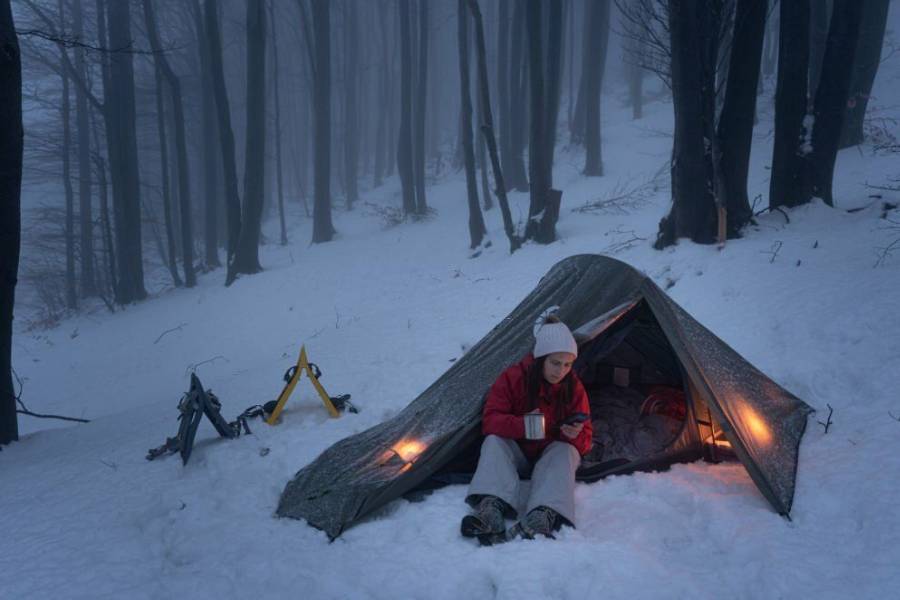
Maintaining a warm and cozy environment inside your tent is not only about choosing the right heater but also about effectively insulating and sealing the space. Here’s how you can do it safely:
- Tent Liners and Blankets: Invest in insulating tent liners or blankets designed to trap heat and keep cold air out. Place these liners on the tent floor and walls to create an additional barrier against the cold ground and outside air.
- Sealing Gaps and Openings: Before setting up your tent, inspect it for any gaps, holes, or openings that could allow cold air to enter. Use seam sealer or specialized tent repair tape to patch up any identified leaks.
- Choosing a Well-Insulated Tent: Opt for a tent with good insulation properties, especially if you anticipate camping in colder conditions. Look for features like double-walled construction, insulated floors, and adequate rainfly coverage.
- Ground Cover and Underlay: Lay down a groundsheet or tarp underneath your tent to provide an extra layer of insulation from the cold ground. Ensure the groundsheet doesn’t extend beyond the tent’s perimeter to prevent rainwater from collecting underneath.
- Blocking Drafts: Use draft stoppers or weather stripping around the zippers and openings to prevent cold air from seeping in. Consider using door flaps or vestibules to create an additional barrier at the entrance.
- Avoiding Condensation: While sealing the tent is important for retaining heat, it’s equally crucial to allow for proper ventilation to prevent condensation buildup. Use adjustable vents or windows to regulate airflow without compromising insulation.
- Reflective Material: Consider using emergency blankets or specialized tent liners with reflective surfaces to bounce back heat toward the interior.
Using Cold Weather Gear for Safe Tent Heating
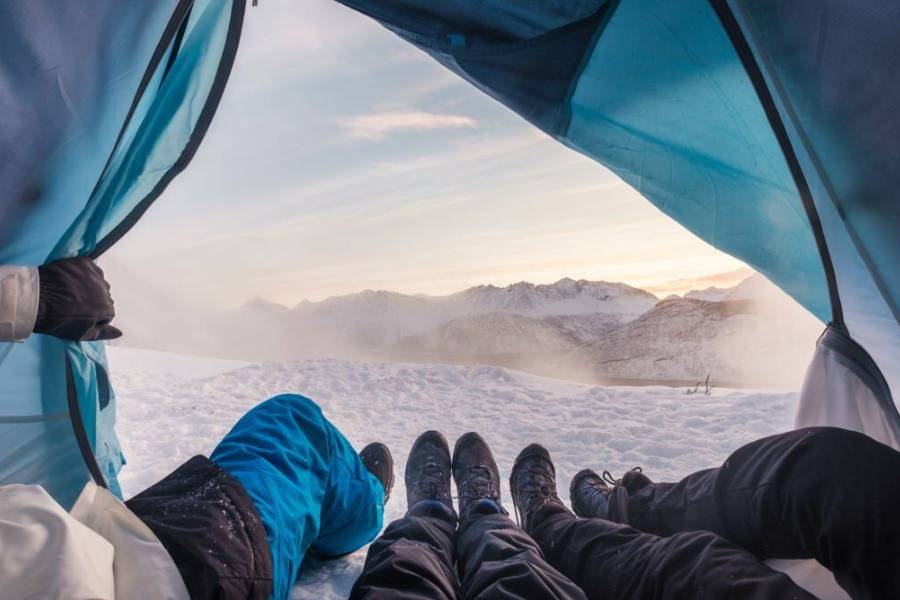
Besides heaters and insulation, having the right cold-weather gear is crucial for staying warm inside your tent. Here are essential items and tips for effective tent heating in colder conditions:
- Insulated Sleeping Bags: Invest in sleeping bags designed for cold weather camping with an appropriate temperature rating. Look for bags with insulation material suitable for lower temperatures.
- Thermal Sleeping Pads or Air Mattresses: Use thermal sleeping pads or insulated air mattresses to create a barrier between your body and the cold ground. Look for options with higher R-values for better insulation.
- Layered Clothing: Wear thermal base layers, insulating mid-layers, and a waterproof outer layer to trap heat close to your body and protect against moisture. Avoid wearing tight-fitting clothing that can restrict blood flow.
- Warm Headwear and Socks: Wear a hat or beanie to prevent heat loss through your head, which is a major source of body heat loss. Use thick and moisture-wicking socks to keep your feet warm and dry.
- Gloves or Mittens: Choose insulated gloves or mittens to keep your hands warm and dexterous when handling heating equipment or during outdoor activities.
- Balaclavas or Neck Gaiters: Use a balaclava or neck gaiter to cover your face and neck. This provides an extra layer of insulation and protection against the cold.
Monitoring Temperature for Safe Tent Heating
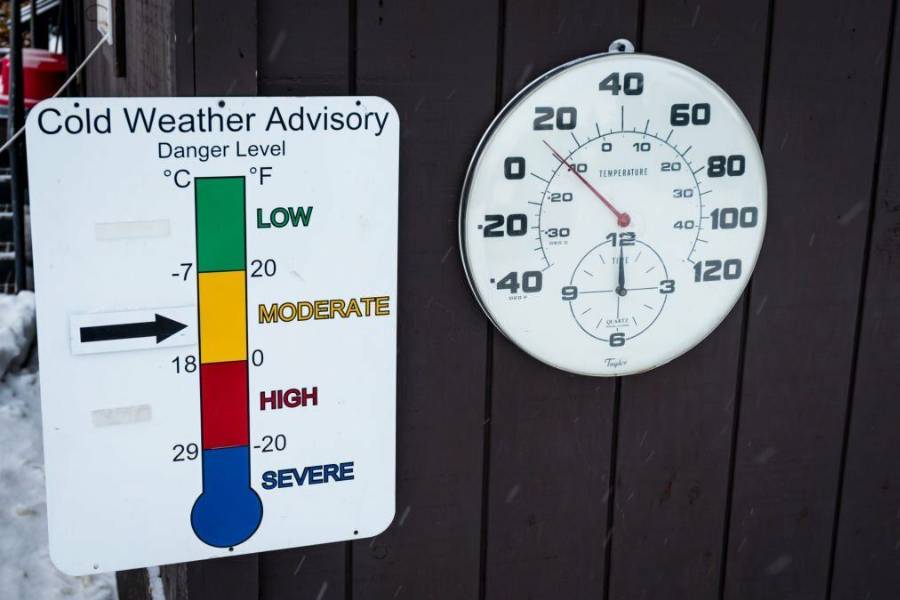
Keeping track of the temperature inside your tent is crucial for maintaining a comfortable and safe environment. Here’s how you can effectively monitor the temperature:
- Use a Thermometer: Choose a reliable and accurate thermometer designed for indoor use, ideally with a digital display for easy reading.
- Placement of the Thermometer: Hang or place the thermometer at a central location inside the tent, away from direct contact with heaters or vents, to get an accurate reading of the ambient temperature.
- Check Regularly: Regularly check the thermometer to observe any fluctuations in temperature, especially during the night when temperatures can drop.
- Adjust Heating Accordingly: Use the thermometer readings to adjust the heating method or intensity as needed to maintain a comfortable temperature inside the tent.
- Ventilation Considerations: Be mindful of how ventilation affects the temperature. Opening vents or windows can help regulate temperature and prevent condensation.
- Monitor Weather Forecasts: Keep an eye on local weather forecasts to prepare for any drastic changes in temperature during your camping trip.
- Consider an Indoor/Outdoor Thermometer: If available, use an indoor/outdoor thermometer to compare the temperature inside the tent with the external conditions.
- Record Temperature Trends: Keep a log of temperature readings over time to better understand how external factors and heating methods influence the tent’s internal temperature.
Emergency Heat Generation in Case of Heater Failure
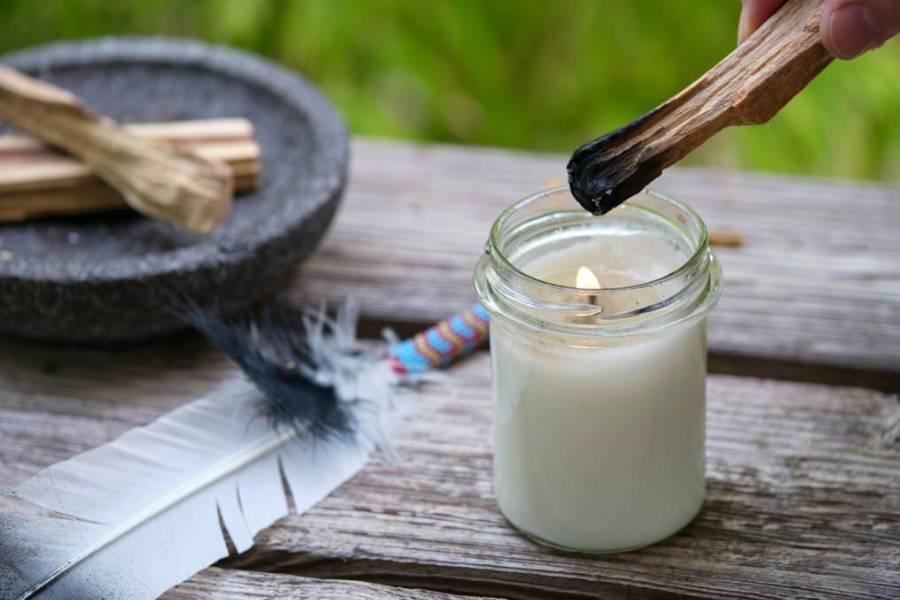
Having a backup plan for generating heat is crucial. Here are some effective strategies:
- DIY Candle Heater: Construct a DIY candle heater using a metal container with a candle inside. Ensure it’s safely positioned and never leave it unattended.
- Rock or Brick Heating: Heat rocks or bricks by fire and place them inside a metal container in your tent. Exercise caution and use heat-resistant gloves.
- Body Heat and Group Huddling: Huddle together with fellow campers to share body heat and create a warmer microclimate inside the tent.
- Windbreaks and Tarps: Set up windbreaks or tarps around your tent to shield it from chilling winds, reducing heat loss.
- Generate Heat Outside the Tent: If allowed in your camping area, create a safe outdoor fire or use a portable camping stove to generate heat outside the tent.
- Campfire or Stove Outside the Tent: If allowed in your camping area, create a safe outdoor fire or use a portable camping stove to generate heat outside the tent. Be cautious with fire safety and follow all local regulations.
- Stay Active: Engage in physical activities like light exercises or even a short walk to increase your body heat.
Related Questions and Answers
Can I use a regular household space heater in my tent?
Using a regular household space heater in a tent is not recommended due to safety concerns. Most household space heaters are designed for indoor use in well-ventilated areas. Tents do not provide the same level of ventilation as a room in a house, which can lead to a buildup of carbon monoxide, a colorless and odorless gas that can be harmful or even deadly in high concentrations.
How can I prevent condensation when using a heater in my tent?
Proper ventilation is key. Crack a window or vent slightly to allow moisture to escape. Investing in an insulated tent with quality materials and construction can significantly mitigate condensation. ”
Can I leave a heater on overnight in my tent?
For safety reasons, it is generally recommended to turn off heaters before going to sleep. However, if you require heat during the night, consider using a heater equipped with a low setting and additional safety features. This precaution ensures a more secure and comfortable camping experience.
Are there any safety measures specific to using a wood-burning stove in a tent?
Yes, plenty. Ensure proper installation with a safe flue system, use a spark arrester, and maintain a clear space around the stove. Always have a fire extinguisher on hand and monitor the stove regularly.
What should I do if my heater runs out of fuel during a cold night?
Have a backup plan ready. Use alternative methods like hand warmers, hot water bottles, or emergency blankets to stay warm until you can replenish your fuel supply.
Can I use a campfire inside my tent for heat?
Absolutely not. It’s extremely dangerous and can lead to a fire hazard and carbon monoxide poisoning. Keep fires outside the tent in designated areas.
What should I do if I suspect carbon monoxide buildup in my tent?
Ventilate the tent immediately by opening all windows and vents. Exit the tent and seek fresh air. Seek medical attention if you experience symptoms of carbon monoxide poisoning.
Conclusion
Understanding how to effectively heat a tent can be the key to transforming a chilly camping trip into a warm and enjoyable experience. By applying these strategies, you can transform your tent into a warm and inviting sanctuary in the midst of the wilderness. Yet, nature can be unpredictable. That’s why it’s wise to have backup plans.
Happy camping!